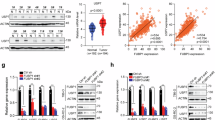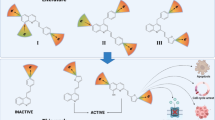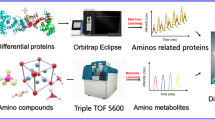Abstract
Two renal cell carcinoma cell lines (49RC 43STR and 75RC 2STR) were characterized by detection of the cell surface proteins: CD44(var), intercellular adhesion molecule-1 (ICAM-1), urokinase-type plasminogen activator (uPA) and its receptor and aminopeptidase N (APN). To detect their localization the immunoluminescent technique was used. In addition, the enzyme activity of uPA and APN was investigated in cell suspensions as well as in monolayers. The latter procedure was more advantageous since the additional use of HPLC permits a single registration of the fluorescent hydrolysis-product AMC (7-amino-4-methylcoumarin) without interference by cellular autofluorescence or non-reacted fluorescent substrate. Unlike 75RC 2STR, the cell line 49RC 43STR expressed high levels of uPA and APN. Contrary to that the cell line 75RC 2STR expressed high levels of ICAM-1 and CD44(v6), whereas 49RC 43STR showed a low level of ICAM-1 and no distinct light signal with anti-CD44(v6). The uPA activity was measured directly as well as indirectly (via plasmin) with the substrate Z-Gly-Gly-Arg-AMC. Both activator and plasmin activity were inhibited by D-Val-Phe-Lys-CMK and phenylmethylsulfonyl fluoride. The anti-catalytic antibody to uPA and that to uPA receptor were found to be inhibiting the uPA activity in a concentration-dependent manner. APN activity was assayed using alanine-p-nitroanilide. Peptidase activity was effectively inhibited by 1,10-phenanthroline and partly inhibited by ethylenediamine-tetraacetic acid. © 2001 Cancer Research Campaign http://www.bjcancer.com
Similar content being viewed by others
Article PDF
Change history
16 November 2011
This paper was modified 12 months after initial publication to switch to Creative Commons licence terms, as noted at publication
References
Andreasen PA, Kjoller L, Christensen L and Duffy MJ (1997) The urokinase-type plasminogen activator system in cancer metastasis: A Review. Int J Cancer 72: 1–22
Cubellis MV, Wun TC and Blasi F (1990) Receptor-mediated internalization and degradation of urokinase is caused by its specific inhibitor PAI-1. EMBO J 9: 1079–1085
Ellis V and Dano K (1998) u-Plasminogen activator. In: Handbook of Proteolytic Enzymes, Barrett AJ, Rawlings ND, Woessner JF (eds) pp 177–184. Academic Press: San Diego
Evans CW (1991). The Metastatic Cell. Behaviour and Biochemistry, pp 206–214. Chapman and Hall: London
Gilcrease MZ, Truong L and Brown RW (1996) Correlation of very late activation integrin and CD44 expression with extrarenal invasion and metastasis of renal cell carcinomas. Human Pathol 27: 1355–1360
Goebeler M, Kaufmann D, Bröcker EB and Klein CE (1996) Migration of highly aggressive melanoma cells on hyaluronic acid is associated with functional changes, increased turnover and shedding of CD44 receptors. J Cell Science 109: 1957–1964
Göhring B, Holzhausen HJ, Meye A, Heynemann H, Rebmann U, Langner J and Riemann D (1998) Endopeptidase 24.11/CD10 is down-regulated in renal cell cancer. Int J Mol Med 2: 409–414
Gohji K, Nakajima M, Boyd D, Dinney CPN, Bucana CD, Kitazana S, Kamidono S and Fidler IJ (1997) Organ-site dependence for the production of urokinase-type plasminogen activator and metastasis by human renal cell carcinoma cells. Am J Pathol 151: 1655–1661
Hansen AB, Lillevang ST and Andersen CB (1994) Stimulation of intercellular adhesion molecule-1 (ICAM-1) antigen expression and shedding by interferon-γ and phorbol ester in human renal carcinoma cell cultures: relation to peripheral blood mononuclear cell adhesion. Urol Res 22: 85–91
Hara I, Miyake H, Yamanaka K, Hara S, Arakawa S and Kamidono S (1999) Expression of CD44 adhesion molecules in nonpapillary renal cell carcinoma and normal kidneys. Urol 54: 562–566
Heider KH, Ratschek M, Zatloukal K and Adolf GR (1996) Expression of CD44 isoforms in human renal cell carcinomas. Virchows Arch 428: 267–273
Hoyer-Hansen G, Ploug M, Behrendt N, Ronne E and Dano K (1997) Cell-surface acceleration of urokinase-catalyzed receptor cleavage. Eur J Biochem 243: 21–26
Kirchheimer JC, Pflüger H, Hienert G and Binder BR (1985) Increased urokinase activity to antigen ratio in human renal-cell carcinoma. Int J Cancer 35: 737–741
Koelsch R, Gottwald S and Lasch J (1994) Release of GPI-anchored membrane aminopeptidase P by enzymes and detergents has some peculiarities. Biochim Biophys Acta 1190: 170–172
Koga H, Naito S, Nakashima M, Hasegawa S, Watanabe T and Kumazawa J (1997) A flow cytometric analysis of the expression of adhesion molecules on human renal cell carcinoma cells with different metastatic potentials. Eur Urol 31: 86–91
Kricka LJ and Thorpe GHG (1990) Bioluminescent and chemiluminescent detection of horseradish peroxidase labels in ligand binder assays. In Luminescence Immunoassay and Molecular Applications, Van Dyke K, Van Dyke R (eds) pp 77–98. CRC Press: Boca Raton
Laube F (1996) Immunoluminescence detection of cathepsin L/procathepsin L at the surface of human lung tumor cells. Biol Chem 377: S 138
Laube F and Göhring B (1997) Detection of CD44 at the cell surface of human tumor cells by immunoluminescence. Eur J Clin Chem Clin Biochem 35: A 112
Laube F (1999a) Cell surface expression of CD44: Detection on tumor cells by immunoluminescence compared to fluorescence analysis. In Bioluminescence and Chemiluminescence: Perspectives for the 21 st Century, Roda A, Pazzagli M, Kricka LJ, Stanley PE (eds) pp 126–129. J. Wiley & Sons: Chichester
Laube F (1999b) Co-Localization of CD44 and urokinase-type plasminogen activator (uPA) on the surface of human melanoma cells. Anticancer Res 19: 5709–5710
Lischke A, Pagany M, Kammer W and Friedrich K (1996) A chemiluminescence-based method for the detection and quantification of antigen-antibody interactions on the surface of eukaryotic cells. Anal Biochem 236: 322–326
Meissauer A, Kramer MD, Schirrmacher V and Brunner G (1992) Generation of cell surface-bound plasmin by cell associated urokinase-type or secreted tissue-type plasminogen activator: A key event in melanoma invasiveness in vitro. Exp Cell Res 199: 179–190
Mohanam S, Sawaya R, McCutcheon I, Ali-Osman F, Boyd D and Rao JS (1993) Modulation of in vitro invasion of human glioblastoma cells by urokinase-type plasminogen activator receptor antibody. Cancer Res 53: 4143–4147
Nanus DM, Papandreou CN and Albino AP (1997) Expression of cell-surface peptidases in neoplastic cells. In Cell-Surface Peptidases in Health and Disease, Kenny AJ, Boustead CM (eds) pp 353–369. BIOS Scientific Publishers: Oxford
Nguyen DHD, Hussaini IM and Gonias SL (1998) Binding of urokinase-type plasminogen activator to its receptor in MCF-7 cells activates extracellular signal-regulated kinase 1 and 2 which is required for increased cellular motility. J Biol Chem 273: 8502–8507
Noren O, Sjöström H and Olsen J (1997) Aminopeptidase N. In Cell-Surface Peptidases in Health and Disease, Kenny AJ, Boustead CM (eds) pp 175–191. BIOS Scientific Publishers: Oxford
Paradis V, Ferlicot S, Ghannam E, Zeimoura L, Blanchet P, Eschwege P, Jardin A, Benoit G and Bedossa P (1999) CD44 is an independent prognostic factor in conventional renal cell carcinomas. J Urol 161: 1984–1987
Penno MB and Hart JC (1998) CD44, hyaluronan and lung cancer. In Cell Adhesion Molecules and Matrix Proteins, Mousa SA (ed) pp 175–190. Springer-Verlag: Berlin
Reuning U, Magdolen V, Wilhelm O, Fischer K, Lutz V, Graeff H and Schmitt M (1998) Multifunctional potential of the plasminogen activation system in tumor invasion and metastasis. Int J Oncol 13: 893–906
Riemann D, Kehlen A and Langner J (1995) Stimulation of the expression and the enzyme activity of aminopeptidase N/CD13 and dipeptidylpeptidase IV/CD26 on human renal cell carcinoma cells and renal tubular epithelial cells by T cell-derived cytokines, such as IL-4 and IL-13. Clin Exp Immunol 100: 277–283
Saiki I, Fujii H, Yoneda J, Abe F, Nakajima M, Tsuruo T and Azuma I (1993) Role of amino peptidase N (CD13) in tumor-cell invasion and extracellular matrix degradation. Int J Cancer 54: 137–143
Stahl A and Mueller BM (1995) The urokinase-type plasminogen activator receptor, a GPI-linked protein, is localized in caveolae. J Cell Biol 129: 335–344
Stahl A and Mueller BM (1997) Melanoma cell migration on vitronectin: regulation by components of the plasminogen activation system. Int J Cancer 71: 116–122
Swiercz R, Wolfe JD, Zaher A and Jankun J (1998) Expression of the plasminogen activation system in kidney cancer correlates with its aggressive phenotype. Clin Cancer Res 4: 869–877
Tanabe K, Campbell SC, Alexander JP, Steinbach F, Edinger MG, Tubbs RR, Novick AC and Klein EA (1997) Molecular regulation of intercellular adhesion molecule 1 (ICAM-1) expression in renal cell carcinoma. Urol Res 25: 231–238
Wagner SN, Atkinson MJ, Thanner S, Wagner C, Schmitt M, Wilhelm O, Rotter M and Höfler H (1995) Modulation of urokinase and urokinase receptor gene expression in human renal cell carcinoma. Am J Pathol 147: 183–192
Yu Q and Stamenkovic I (1999) Localization of matrix metalloproteinase 9 to the cell surface provides a mechanism for CD44-mediated tumor invasion. Genes & Dev 13: 35–48
Zimmerman M, Quigley JP, Ashe B, Dorn C, Goldfarb R and Troll W (1978) Direct fluorescent assay of urokinase and plasminogen activators of normal and malignant cells: Kinetics and inhibitor profiles. Proc Natl Acad Sci USA 75: 750–753
Author information
Authors and Affiliations
Rights and permissions
From twelve months after its original publication, this work is licensed under the Creative Commons Attribution-NonCommercial-Share Alike 3.0 Unported License. To view a copy of this license, visit http://creativecommons.org/licenses/by-nc-sa/3.0/
About this article
Cite this article
Laube, F., Göhring, B., Sann, H. et al. Cell surface antigens in renal tumour cells: detection by immunoluminescence and enzymatic analysis. Br J Cancer 85, 924–929 (2001). https://doi.org/10.1054/bjoc.2001.2004
Received:
Accepted:
Published:
Issue date:
DOI: https://doi.org/10.1054/bjoc.2001.2004



